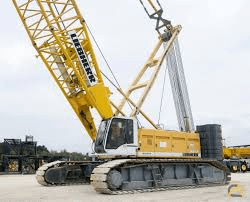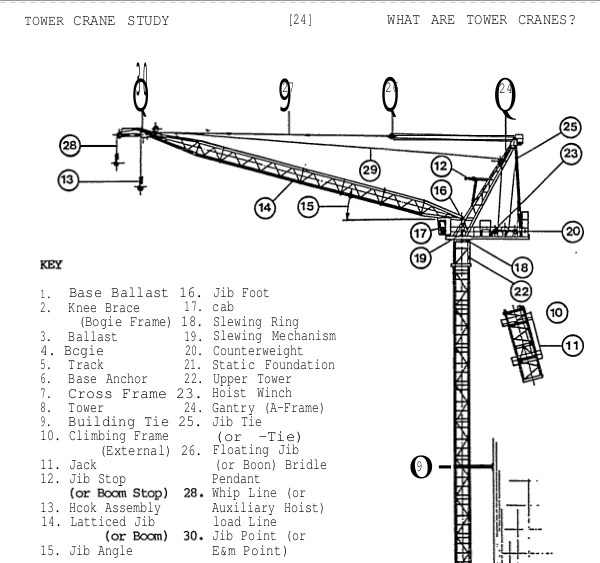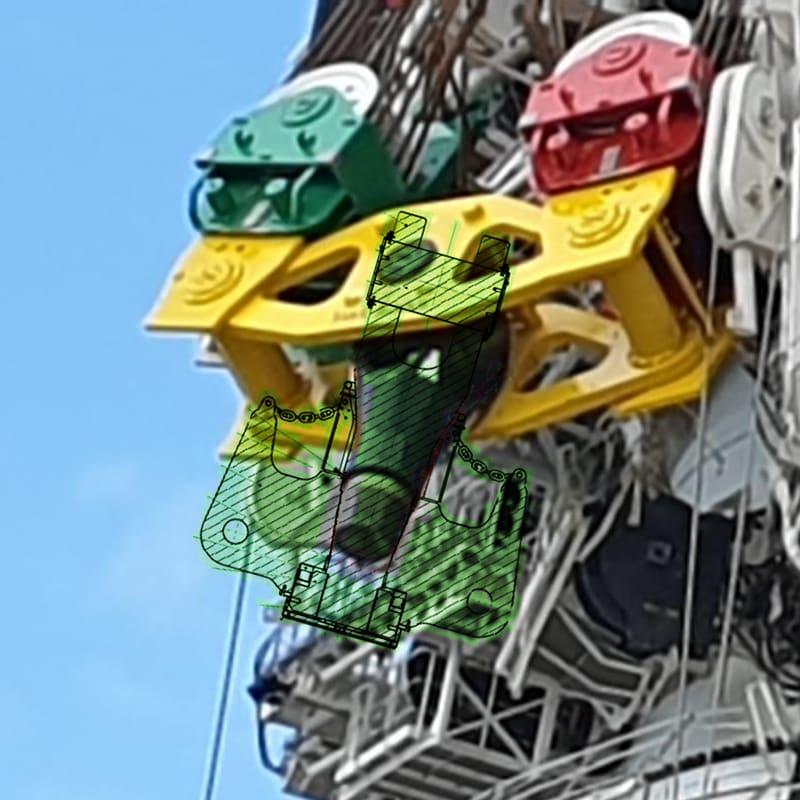supposedly the hook failed and boom slingshot over the top.
Navigation
Install the app
How to install the app on iOS
Follow along with the video below to see how to install our site as a web app on your home screen.
Note: This feature may not be available in some browsers.
More options
Style variation
-
Congratulations cowski on being selected by the Eng-Tips community for having the most helpful posts in the forums last week. Way to Go!
You are using an out of date browser. It may not display this or other websites correctly.
You should upgrade or use an alternative browser.
You should upgrade or use an alternative browser.
Liebherr Orion crane failure under 5500t load test 7
- Thread starter tommj
- Start date
- Status
- Not open for further replies.
LittleInch
Petroleum
A bit more info here:
Apparently the hook block failed and what you see on the video is the crane jib flicking over backwards and given it wasn't designed for it collapsing at the mid point.
This photo shows it before and you can see the lack of rear flip capacity of the top half of the boom.

from here
The 5000 tonne capacity is clearly at minimum boom angle, but if it snaps then the whip back can't be avoided for high angle operation.
Remember - More details = better answers
Also: If you get a response it's polite to respond to it.
Apparently the hook block failed and what you see on the video is the crane jib flicking over backwards and given it wasn't designed for it collapsing at the mid point.
This photo shows it before and you can see the lack of rear flip capacity of the top half of the boom.

from here
The 5000 tonne capacity is clearly at minimum boom angle, but if it snaps then the whip back can't be avoided for high angle operation.
Remember - More details = better answers
Also: If you get a response it's polite to respond to it.
- Thread starter
- #3
Good view here. Supposedly the hook was made by Ropeblock, I am curious to see how these are constructed especially how the hook portion is retained to that center pin. I was not able to find a good cross section.
charliealphabravo
Structural
What would "rear flip capacity" look like? Is it a strut or a cable system?
Edit:
1. Equipment owned by Cosco. Not good timing considering the mass of inventory they probably want to move in a short time.
2. Amazing that the 4 point hook just snapped off. It is hard to tell how it was secured to the shaft. Perhaps some weldment failed or someone forgot shear pins.
3. I'm wondering if the hook assembly had some type of fuseable link designed to prevent overloading. Even so I'd think it would have a safety factor of at least 2 or 5.
4. Sorry, one more comment. The uncertainty of the load has to be a prime concern for a ship mounted crane to avoid capsizing. How could they not consider the reaction due to loss of load?
Edit:
1. Equipment owned by Cosco. Not good timing considering the mass of inventory they probably want to move in a short time.
2. Amazing that the 4 point hook just snapped off. It is hard to tell how it was secured to the shaft. Perhaps some weldment failed or someone forgot shear pins.
3. I'm wondering if the hook assembly had some type of fuseable link designed to prevent overloading. Even so I'd think it would have a safety factor of at least 2 or 5.
4. Sorry, one more comment. The uncertainty of the load has to be a prime concern for a ship mounted crane to avoid capsizing. How could they not consider the reaction due to loss of load?
- Moderator
- #5
It is a tubular member telescoping inside a larger tubular member, trombone style.
One part is pivoted from a fixed member, in the illustration midway on the top of the machinery housing, and the other part is pivoted to the boom.

The two back stops look like hydraulic cylinders.
They may stop wind events but given the violence of this event they would not have helped.
The tower or gantry would have acted as a back stop, but the upward reaction was so powerful that it bent the boom over the tower.
Conventional telescopic stops low on the boom would have been much less effective.
Bill
--------------------
"Why not the best?"
Jimmy Carter
One part is pivoted from a fixed member, in the illustration midway on the top of the machinery housing, and the other part is pivoted to the boom.

The two back stops look like hydraulic cylinders.
They may stop wind events but given the violence of this event they would not have helped.
The tower or gantry would have acted as a back stop, but the upward reaction was so powerful that it bent the boom over the tower.
Conventional telescopic stops low on the boom would have been much less effective.
Bill
--------------------
"Why not the best?"
Jimmy Carter
- Moderator
- #6
At one time jibs were protected by a cable system.
A strut was pivoted near the pivot between the main boom and the jib and swung below the pivot.
Slack cables ran from a point on the main boom through the end of the strut and to the jib.
The cables came tight when the jib reached the maximum allowable upward position.
These systems seem to have fallen out of favour.
On a large crane they may do more damage to the jib than they prevent.
Bill
--------------------
"Why not the best?"
Jimmy Carter
A strut was pivoted near the pivot between the main boom and the jib and swung below the pivot.
Slack cables ran from a point on the main boom through the end of the strut and to the jib.
The cables came tight when the jib reached the maximum allowable upward position.
These systems seem to have fallen out of favour.
On a large crane they may do more damage to the jib than they prevent.
Bill
--------------------
"Why not the best?"
Jimmy Carter
- Thread starter
- #7
charliealphabravo
Structural
That makes sense.
Apparently this crane has no counterweights and uses water pumped into ballast tanks. There must be a huge amount of energy stored in the loaded system due to cables elongation, jib deflection, ship rotation, and the sudden out-of-balance condition of the ballast tanks. It seems like a sudden loss of load is simply a catastrophic, unrecoverable event.
Apparently this crane has no counterweights and uses water pumped into ballast tanks. There must be a huge amount of energy stored in the loaded system due to cables elongation, jib deflection, ship rotation, and the sudden out-of-balance condition of the ballast tanks. It seems like a sudden loss of load is simply a catastrophic, unrecoverable event.
Looks like a Din 15402-c Quad Forged Hooks. These hooks are forged. Unlike single and duplex hooks, the bottom shank is very challenging to perform NDE. There are not many forges capable of making a 5000T Quad Hook. Did you notice at the end of the front prop for the sheave assembly is bent. Most likely all of the structure above the machinery house will need to be removed before repairs can start. This is going to be challenging.
Fred
Fred
- Moderator
- #11
Did you mean the fron member of the gantry? that is bent.the front prop for the sheave assembly is bent.
Same thing, different names?
I wonder if some of the injuries were self inflicted when diving for cover?Must have been very exciting in the control room
I made more than one frantic run or dive working as a logger out west.
Finally sanity prevailed over the adrenaline rush and I quit and went back to school.
Bill
--------------------
"Why not the best?"
Jimmy Carter
Eufalconimorph
Computer
Some more detail (including a schematic of the hook, with a possible failure plane drawn on) and pictures in this imgur album:
Whoever drew the failure plane seems to think the center pin snapped.
Whoever drew the failure plane seems to think the center pin snapped.
- Thread starter
- #16
waross You are correct the assembly which holds the luffing sheaves is called a Gantry by some and an A Frame by others
 .
.
What I was trying to point out is the tension member which the boom is resting on, has taken the shape of the boom. In the first picture provided by Eufalconimorph, the member is straight. Once a large box section is bent it is usually less expensive to discard it and start over.
Well that is not a Din 15402-c Quad Forged Hooks. The red line is not correct. In this photo (screenshot from Eufalconimorph's set
) The bottom of the taper the cylindrical section, which is threaded is still attached to the shank.

Possibilities -
1) The nut cracked and the inside diameter increased until the threads no longer engaged each other.
2) Threads stripped.
I am out of guesses
Fred

What I was trying to point out is the tension member which the boom is resting on, has taken the shape of the boom. In the first picture provided by Eufalconimorph, the member is straight. Once a large box section is bent it is usually less expensive to discard it and start over.
Well that is not a Din 15402-c Quad Forged Hooks. The red line is not correct. In this photo (screenshot from Eufalconimorph's set
) The bottom of the taper the cylindrical section, which is threaded is still attached to the shank.

Possibilities -
1) The nut cracked and the inside diameter increased until the threads no longer engaged each other.
2) Threads stripped.
I am out of guesses
Fred
Eufalconimorph (Computer) 6 May 20 00:18 said:Some more detail (including a schematic of the hook, with a possible failure plane drawn on) and pictures in this imgur album:
Whoever drew the failure plane seems to think the center pin snapped.
Granted, the following overlay of images from the quoted link is very crude, I would agree with the assesment that the failure was in the pin, at or above the seat of the nut. With this failure occurring at less than half the design load, it will be interesting to learn what metallurgical flaws were present and why they weren't discovered earlier in the fab process.

- Status
- Not open for further replies.
Similar threads
- Replies
- 1
- Views
- 3K
- Replies
- 17
- Views
- 1K
- Replies
- 12
- Views
- 7K
- Replies
- 10
- Views
- 4K
- Locked
- Question
- Replies
- 1
- Views
- 2K
